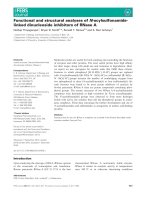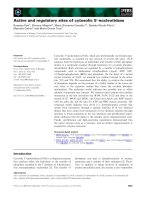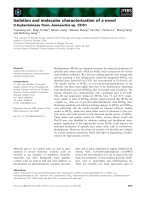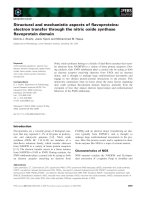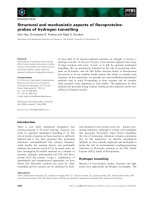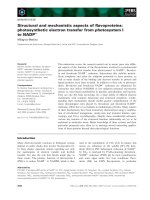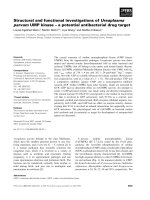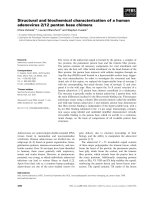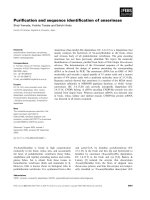Báo cáo khoa học: "Physiological and pathological aspects of long-term storage of acorns" potx
Bạn đang xem bản rút gọn của tài liệu. Xem và tải ngay bản đầy đủ của tài liệu tại đây (214.45 KB, 4 trang )
Original
article
Physiological
and
pathological
aspects
of
long-term
storage
of
acorns
J
Guthke
W
Spethmann
Universität
Hannover,
Institut
für
Obstau
und
Baumschule,
Am
Steinberg
3,
3203
Sarstedt,
Germany
Summary —
The
development
of
a
seedlot
of
oak
has
been
followed
over a
period
of
32
months.
During
the
observation
period,
the
absolute
starch
content
of
acorns
and
the
exploitation
of
starch
reserves
at
germination
decreased
with
increasing
duration
of
storage.
Ageing
processes
are
prob-
ably
impairing
the
availability
of
food
reserves.
After
12
months,
a
marked
decrease
in
germination
capacity
appeared,
caused
by
a
fungal
disease.
However,
the
low
storage
temperature
and
high
CO
2
content
seem
to
have
stressed
the
acorns
which
has
probably
predisposed
them
to
infection
with
the
weak
pathogen,
Cylindrocarpon
didymum.
Under
natural
conditions,
the
acorns
developed
typical
frost
hardiness.
acorn
storage
/ germination
/ food
reserves
/ frost
hardiness
Résumé —
Aspects
physiologiques
et
pathologiques
de
la
conservation
des
glands
à
long
terme.
Le
développement
d’un
lot
de
glands
a
été
observé
pendant
une
période
de
32
mois.
Pen-
dant
la
période
observée,
la
teneur
absolue
en
amidon
et
l’utilisation
des
réserves
d’amidon
des
glands
ont
diminué
avec
l’augmentation
de
la
durée
de
conservation.
Il
est
possible
que
le
proces-
sus
de
vieillissement
réduise
la
disponibilité
des
réserves
nutritives.
Après
12
mois,
une
diminution
nette
de
la
faculté
germinative
s’est
manifestée,
causée
par
une
infection
fongique.
Il
semble
que
la
température
basse
et
les
teneurs
en
CO
2
élevées
constituent
des
facteurs
de
stress
sur
les
glands,
qui
pourraient
favoriser
l’infection
par
le
champignon
Cylindrocarpon
didymum.
Dans
les
conditions
naturelles,
les
glands
manifestent
une
résistance
au
gel.
conservation
des
glands
/ germination
/ réserves
nutritives
/ résistance
au
gel
INTRODUCTION
Knowledge
of
physiological
processes
in
seeds
is
a
prerequisite
for
the
develop-
ment
of
seed-storage
methods.
The
cur-
rent
rule of
thumb
is
that
a
water
content
of
40%
and
a
temperature
of
-4 °C
are
the
minima
acorns
require
to
survive
(Holmes
and
Buszewicz,
1956;
von
Schönborn,
1964;
Bonnet-Masimbert
et al,
1977;
Susz-
ka
and
Tylkowski,
1980;
Muller
and
Bon-
net-Masimbert,
1984).
Nevertheless,
traditional
but
also
cur-
rent
methods
are
not
up
to
the
high
stan-
dards
required
for
seed
storage
today
and
in
the
future.
Above
all,
for
gene
conserva-
tion,
improved
methods
will
be
necessary.
In
the
context
of
a
long-term
storage
project
at
the
University
of
Hannover,
the
physiological
development
during
storage
and
germination
of
different
oak
seedlots
were
observed
from
November
1988.
Ad-
ditional
investigations
were
concerned
with
the
ecophysiological
behavior
during
the
development
of
winter-hardiness
(Guthke
and
Spethmann,
1991a,b).
MATERIALS
AND
METHODS
The
long-term
storage
trial
started
in
November
1988
with
250
kg
of
Quercus
petraea
acorns
from
Lüß.
After
thermotherapy
(2
h
in
42
°C
hot
water;
Delatour,
1978)
and
surface-drying,
the
acorns
were
placed
in
boxes
with
dry
peat
and
put
into
a
jacket
cooling
at
-2
°C.
At
this
stage,
the
acorns
had
a
water
content
of
54%.
Differ-
ent
CO
2
contents
(0.5,
1,
3
and
5%)
were
ap-
plied.
Every
4
months,
a
sample
was
taken.
Fresh
weight,
germination
and
fungal
infection
were
determined
for
700-1200
acorns/CO
2-
treatment.
200-300
obviously
sound
acorns
were
taken
from
each
group
for
a
cutting-test.
The
fresh
matter
of
the
really
sound
acorns
was
instantly
deep
frozen
and
later
dried
to
constant
weight
over
about
1
week
at
70
°C.
The
cotyle-
don
dry
matter
was
ground
for
analysis
to
<
0.25
mm.
Another
200 acorns
were
sown
for
a
germination
test
at
each
sampling
date.
When
the
first
leaves
on
the
epicotyl
began
to
appear,
a
sample
of
50
seedlings/treatment
was
taken
to
determine
the
consumption
of
food
reserves
and
build-up
of
shoot
and
root
dry
matter.
To
investigate
the
development
of
winter-
hardiness,
acorns
were
sown
in
a
forest
and
a
nursery
seedbed.
Every
30
days,
samples
were
taken
for
analyses
(as
above)
and
laboratory
frost-hardiness
test
were
run
for
about
20
days
at
specific
temperatures.
The
great
variability
within
the
acorn
popula-
tion
contrasted
with
a
variance-analytical
inter-
pretation
of
the
results.
The
observed
pathologi-
cal
disintegration
of
the
population
also
impeded
statistical
evaluations.
RESULTS
The
temperature
of
-2 °C
proved
not
to
be
low
enough
to
prevent
germination
in
stor-
age.
Within
12
months,
epicotyls
began
to
appear.
A
specific
aim
of
the
study
was
to
deter-
mine
the
influence
of
CO
2
on
stored
acorns
(fig
1).
This
aim
failed
because
of
fungal
invasion
but,
nevertheless,
it
was
possible
to
assess
the
physiological
and
pathological
aspects
of
acorn
ageing.
Although
thermotherapy
was
reason-
ably
effective
against
attack
by
Ciboria
batschiana,
it
failed
to
protect
against
other
microorganisms.
After
12
months,
there
was
a
distinct-wide
decrease
in
germina-
tion
capacity
caused
by
another
fungal
dis-
ease,
possibly
Cylindrocarpon
didymum.
At
higher
CO
2
concentrations
the
fungal
in-
fection
was
even
worse.
The
dry
matter
of
sound
acorns
(after
the
cutting
test)
fluctuated
and
a
relation-
ship
could
not
always
be
shown
with
the
dry
matter
residue
after
the
germination
test.
Therefore,
different
dry
weights
were
calculated
in
comparison
to
the
original
fresh
weight
of
the
whole
samples
and
to
the
acorn
residues
after
germination.
It
turned
out
that
the
sound
acorns
analyzed
were
heavier
than
the
mean
of
the
whole
population
and
the
germinated
acorns
were
even
heavier
than
the
sound
acorns,
especially
in
the
last
year.
Another
feature
observed
was
the
de-
velopment
of
starch
(%)
during
storage
(fig
2).
While
the
starch
weight
decreased
con-
tinuously,
the
percentage
did
not
change
but
fluctuated
around
35%.
Since
only
sound
acorns
were
analyzed,
it
seems
probable
that
not
only
heavier
acorns
but
also
acorns
with
a
higher
percentage
of
starch
were
more
viable.
After
prolonged
acorn
storage,
seed-
lings
showed
gradual
reductions
in
shoot
and
root
dry
matter.
It
is
not
yet
clear
if
the
decrease
in
shoot
and
root
dry
matter
was
only
associated
with
decreased
acorn
dry
matter
before
the
germination
test.
A
dis-
tinct
decrease
also
appeared
in
the
per-
centage
of
starch
consumed
at
germina-
tion,
so
that
exploitation
of
food
reserves
could
be
impaired.
An
additional
investigation
was
explored
as
to
how
acorns
survive
the
winter
under
natural
conditions.
Even
during
the
quite
warm
winter
of
1989-1990,
acorns
showed
typical
development
of
frost
hardiness
(fig
3).
About
50%
of
the
acorns
survived
at
la-
boratory
tests
-8 °C
in
January.
Unexpectedly,
water
content
increased
from
49%
in
October
to
62%
in
March.
Sugar
content
increased
with
the
develop-
ment
of
frost
hardiness.
Sugars
exhibited
a
distinct
reaction
to
cold,
especially
in
the
cell
sap.
Cutting
tests
showed,
by
the
natu-
ral
browning
reaction
of
frost
damaged
tis-
sues,
that
frost
hardiness
of
the
acorn
was
higher
around
the
embryo
axis
and
in
inner
areas
than
in
outer
ones
(Guthke
and
Spethmnn,
1991a,
b).
DISCUSSION
One
aim
of
this
storage
trial
was
to
investi-
gate
the
influence
of
elevated
CO
2
content
which
seemed
to
be
a
suitable
way
of
re-
ducing
the
metabolism
of
acorns.
This
ef-
fect
cannot
be
excluded,
but
it
was
impos-
sible
to
prove
because,
simultaneously,
infection
with
Cylindrocarpon
increased
with
the
CO
2
concentration.
It
is
possible
that
Cylindrocarpon
infection
is
stimulated
by
elevated
CO
2,
but
this
was
not
investi-
gated.
Apart
from
this
obvious
pathological
development,
some
symptoms
of
physio-
logical
ageing
of
the
acorns
were
also
evi-
dent.
In
addition
to
the
gradual
reduction
of
shoot
and
root
dry
matter
development
at
germination,
the
exploitation
of
starch
at
germination
was
reduced
and
may
have
resulted
from
a
reduced
availability
of
food
reserves.
In
respect
to
these
ageing
pro-
cesses
and
the
more
obvious
physiological
and
pathological
disintegration
of
the
popu-
lations,
it
also
seems
to
be
necessary
to
in-
vestigate
the
genetic
development
of
fur-
ther
storage
trials.
New
methods
must
be
found
to
solve
the
old
problem
of
acorn
storage.
A
prom-
ising
way
may
be
a
controlled
hardening
treatment
of
acorns.
REFERENCES
Bonnet-Masimbert
M,
Muller
C,
Morelet
M
(1977)
De
nouveaux
espoirs
pour
la
conservation
des
glands.
Bull
Tech
Off Nat
For 9,
47-54
Delatour
C
(1978)
Recherche
d’une
méthode
de
lutte
curative
contre
le
Ciboria
batschiana
(Zopf)
Buchwald
chez
les
glands.
Eur
J
For
Pathol 8,
193-200
Guthke
J,
Spethmann
W
(1991 a)
Abhärtung
von
Eicheln
an
ihrem
natürlichen
Standort.
Wis-
senschaftliche
Arbeitstagung
des
BDGL,
Uni-
versität
Hannover
27/02-01/03/1991,
BDGL-
Schriftenreihe
9,
78
Guthke
J,
Spethmann
W
(1991b)
Frost
hardi-
ness
of
acorns
is
induceable!
INRA-
Congress
Génétique
des
Chênes,
Nogent-
sur-Vernisson,
01-06
Sept
1991,
Poster
Holmes
GD,
Buszewicz
G
(1956)
Reports
on
re-
sults
of
individual
investigations.
III.
Longevi-
ty
of
acorns
with
several
storage
methods.
Report
on
Forest
Research
1955.
Ann
Rep
Forestry
Comm
1956
Muller
C,
Bonnet-Masimbert
M
(1984)
La
con-
servation
des
glands.
In:
Bilan
des
Essais
Menés
entre
1976
et
1982.
INRA
Centre
de
Recherches
d’Orléans
Von
Schönborn
A
(1964)
Die
Aufbewahrung
des
Saatgutes
der
Waldbäume.
BLV-
Verlagsgesellschaft,
Münich
Suszka
B,
Tylkowski
T
(1980)
Storage
of
acorns
of
the
English
oak
(Q
robur
L)
over
1-5
win-
ters.
Arbor
Kórnickie
25,
199-229
